Wires Crossed
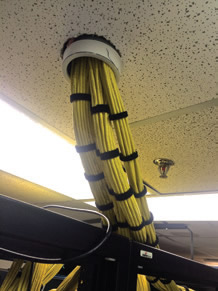
PHOTOS BY ANDREW LAROWE
Often, district technology and facilities departments operate independently, even though they perform similar tasks in support of the instructional program. As we continue to look for effective solutions to conserve resources and reduce costs in school buildings, it is critical for these two organizations to work as a team.
It was not so long ago that many school districts did not have an IT department. Wiring was the exclusive responsibility of the electricians in the Maintenance department. There were very few low voltage systems in school buildings including the thermostats, the intercom, the fire alarm system and the telephones, and they were all connected to a central location in the building, usually the main office. Although it may not have appeared so at the time, the maintenance and operations of early technology-based building systems were relatively simple. And then it all changed.
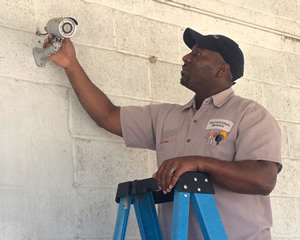
PHOTOS BY ANDREW LAROWE
To understand the radical shift in connectivity school facilities have taken, take a walk through a new school building a few weeks before it is ready to open. The sheer amount of wiring and cabling neatly bundled in overhead cable trays leading to the media center, equipment rooms, technology closets and the office is astonishing. Nearly every room in every building on the school campus is connected to a massive technology infrastructure. Ultimately, it is the collective result of planners, designers, technicians, and contractors who have diligently worked together to provide access to instructional technology, to maintain comfort and safety and to operate multiple building systems efficiently.
Building a new school or renovating an existing one requires many highly trained professionals working closely together so that the technology infrastructure in its entirety performs correctly. So it follows that maintaining and operating the technology infrastructure also demands highly skilled individuals working closely together for all of these complex systems to continuously function as intended. In almost every school district today, this role is a shared multiple function of the Maintenance department and the IT or Technology department. Each of these two organizations is dependent upon the cooperation of the other to meet this responsibility. Typically, they are organized as independent entities and, unfortunately, they often operate separately in a silo mindset. The lack of collaboration in the management of technology-based systems leads to higher costs, longer downtimes, frequent delays and multiple inefficiencies throughout the entire school district.
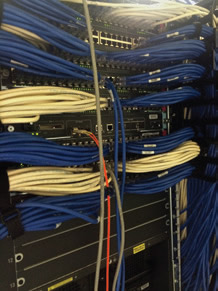
PHOTOS BY ANDREW LAROWE
Shared Responsibility. A school maintenance employee makes adjustments on a camera. In the past, maintenance of electronic components in an educational facility was relatively simple, and the responsibility of the maintenance department, but that is no longer the case. It takes the cooperative efforts of both the Maintenance and IT departments to keep a school’s electronic devices and infrastructure operating properly.
For example, consider the rapid growth of security camera installations in schools. For a variety of reasons, primarily safety and security, cameras have become a standard building system component for many school districts. The average camera count is usually 25 per school although sometimes high school campuses have well over 100. Design and installation are rarely performed in-house, but at some point ongoing maintenance and repair of this (now critical) equipment becomes the school district’s responsibility. This may happen immediately following the installation of equipment, or it may occur a year or two after the installation when the warranty period has expired. The question becomes, which department within the district has functional ownership?
For the Maintenance department, the cameras seem no different than computers connected to a server and tied into the network. If any part of the surveillance system is not working, there is very little maintenance can do without technicians who have received special training and equipment. Although the Technology department has technicians capable of troubleshooting and repairing various systems connected to the network, to them security cameras are no different than fire alarm systems, intercoms, and HVAC controls, all of which are inherently the responsibility of Maintenance. Without a formal vehicle for coordination it is easy to see how the responsibilities for repair could become redundant and/or misunderstood.
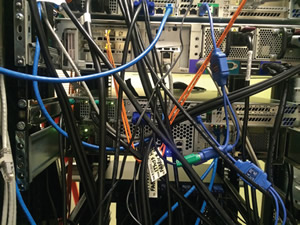
PHOTOS BY ANDREW LAROWE
With individual schools and school districts packing more and more technology into their buildings, cameras are only one example of a broad spectrum of building systems that follow a similar path when it comes to maintenance and repairs. Some of the systems are integrated into to the instructional program such as interactive whiteboards, digital projectors, or voice enhancement systems for instructors. Others are part of the operation of the school building controlling lighting, room temperature, security and safety. Most of these systems have four basic requirements: a need for electrical power, a space for equipment to be placed or installed, a connection to the Internet through the district’s IT network, and maintenance.
Like most of the challenges educational facility managers face, there is not an easy way to solve the maintenance coordination problem. When it comes to the issues of interdependent responsibilities, there is no perfect solution, but it certainly must begin with awareness. Rather than dealing with the issues of coordination, many districts have simply made each department responsible for the on-going maintenance of whatever systems they install. While the “if you install it, you maintain it” protocol may seem a simple solution, there is still such a complex interface between the responsibilities of the two departments that inevitably there is no way to avoid significant communication in order to avoid duplication of effort on one end of the spectrum or neglect on the other.
Scott Denton, assistant superintendent of Auxiliary Services with Durham Public Schools in North Carolina offers, “Before determining who “owns” responsibility for troubleshooting and maintenance of the systems, having the stakeholders at the table to evaluate the products under consideration is key to successful long term maintenance of the systems. Having a seat at the table works wonders for the relationship between IT and Maintenance employees. Building effective connections between the two organizations goes a long way in keeping these systems operational.”
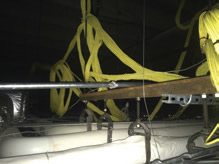
PHOTOS BY ANDREW LAROWE
Wire Chaos! That may be what it appears to be, but it is not. Those bundles of wiring and cabling neatly tucked up in overhead cable trays leading to the media center, equipment rooms, technology closets and the office weren’t randomly strung up there. Now that almost every room in every building in the school is connected to a massive technology infrastructure, a lot of planning needs to take place — and that includes its upkeep.
Clearly, it is time to examine the working relationship between the Maintenance department and IT to remove barriers and encourage collaboration. It may not be economically feasible to outsource system maintenance and repairs for each of the technology-based building systems showing up in school buildings. Out of necessity, maintenance departments have created relationships to service HVAC controls, which are connected to the network. The same is true for technology departments working with maintenance to provide support for desktop computers, servers, and all of the associated equipment. We will need to apply similar thought processes in all other areas of technology integration. An effective organizational design and diagram should not only include a clear linear reporting structure and delineation of tasks (the boxes and the solid lines), but also cross-functional coordination links in this case between the IT and maintenance departments to formalize the decision-making and information sharing (the dotted lines).
The significant investment made in purchasing and installing technology-based systems also demands a program for sustainability. Part of the solution begins with a critical focus with the operations budget and organizational structure. Most school systems now understand that computers become obsolete before they are inoperable, and therefore must include a budget for routine replacement unless the computers are leased. Likewise, the same circumstances are true for all electronic devices including security cameras, building automation systems, energy monitoring equipment, and the cabling and technology infrastructure that provides connectivity. If the district decides to fund electronic devices and infrastructure, it must also set aside funding to keep them up to date and functional.
This article originally appeared in the issue of .